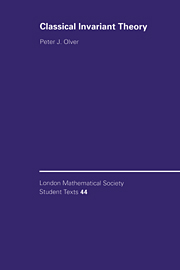Book contents
- Frontmatter
- Contents
- Introduction
- 1 Prelude — Quadratic Polynomials and Quadratic Forms
- 2 Basic Invariant Theory for Binary Forms
- 3 Groups and Transformations
- 4 Representations and Invariants
- 5 Transvectants
- 6 Symbolic Methods
- 7 Graphical Methods
- 8 Lie Groups and Moving Frames
- 9 Infinitesimal Methods
- 10 Multivariate Polynomials
- References
- Author Index
- Subiect Index
4 - Representations and Invariants
Published online by Cambridge University Press: 08 January 2010
- Frontmatter
- Contents
- Introduction
- 1 Prelude — Quadratic Polynomials and Quadratic Forms
- 2 Basic Invariant Theory for Binary Forms
- 3 Groups and Transformations
- 4 Representations and Invariants
- 5 Transvectants
- 6 Symbolic Methods
- 7 Graphical Methods
- 8 Lie Groups and Moving Frames
- 9 Infinitesimal Methods
- 10 Multivariate Polynomials
- References
- Author Index
- Subiect Index
Summary
While general transformation groups play a ubiquitous role in geometry, the most important for invariant theoretic purposes are the linear versions (along with their projective counterparts). Linear group actions are referred to as “representations”, so as to distinguish them from the more general nonlinear transformation groups. Representation theory is a vast field of mathematical research, and we shall only have room to survey its most elementary aspects, concentrating on those which are relevant to our subject. More complete treatments can be found in numerous reference texts, including. Representation theory has an amazing range of applications in physics and mathematics, including special function theory, quantum mechanics and particle physics, solid state physics, probability, harmonic and Fourier analysis, number theory, combinatorics, bifurcation theory, and many other fields. A quote of I. M. Gel'fand, “ … all of mathematics is some kind of representation theory …”, is perhaps not as far-fetched as it might initially seem! The representations of a general (even nonlinear) transformation group on the scalar-valued functions defined on the space where the group acts are of particular importance. In classical invariant theory, our original transformation rules for inhomogeneous and homogeneous polynomials are very special cases of the general framework of group representations on function spaces. In this fashion, we are led back to our primary subject, renewed and reinvigorated by an understanding of the requisite mathematical theory.
Representations
For simplicity we shall state the basic concepts in representation theory in the context of real group actions on real vector spaces; the corresponding complex version is an immediate adaptation and it is left to the reader to fill in the details.
- Type
- Chapter
- Information
- Classical Invariant Theory , pp. 62 - 85Publisher: Cambridge University PressPrint publication year: 1999



